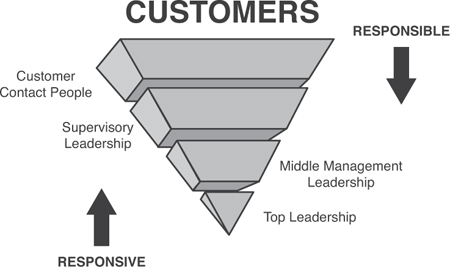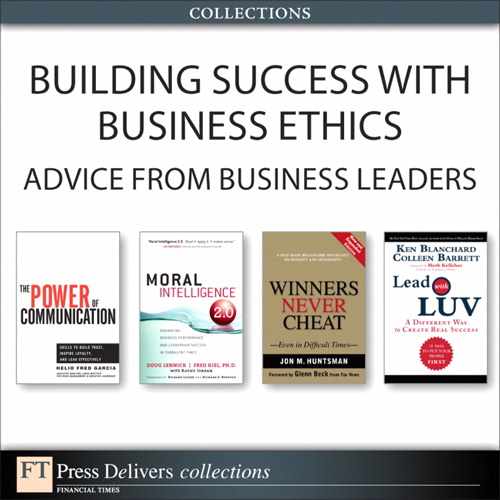What Makes Servant Leadership Work?
K: Amen! Now let’s see if we can put this all together. As we said, vision and direction are the leadership part of Servant Leadership. In establishing where you are going, the traditional pyramidal hierarchy is alive and well. That doesn’t mean that top managers—I mean leaders—don’t involve others in crafting this direction, but the responsibility for vision and direction falls to the hierarchical leadership. Kids look to their parents, players look to their coaches, and people look to their organizational leaders for direction. Max De Pree, legendary former chairman of Herman Miller and author of Leadership Is an Art, compared this strategic role to that of a third-grade teacher who keeps repeating the basics: “When it comes to vision, values, and direction, you have to say it over and over and over again until people get it right, right, right!”14
In a traditional organization, for the operational, or servant, aspect of Servant Leadership, hierarchical leaders are once again thought of as having sole responsibility, and people throughout the organization are taught to be responsive to their boss. “Boss watching” becomes a popular sport, and people are promoted based on their upward-influencing skills. That activity doesn’t do much for accomplishing the strategic vision/direction. All people try to do is protect themselves, rather than move the organization in the desired direction.
Servant Leaders, on the other hand, feel their role is to help people achieve their goals. To do that, the traditional pyramid hierarchy is theoretically turned upside down so that the frontline people, who are closest to the customers, are at the top. Now they are responsible—able to respond—to the needs of the customers. In this scenario, leaders serve and are responsive to people’s needs, training and developing them to soar like eagles so they can accomplish established goals and live according to the vision and values.

The Servant Aspect of Servant Leadership
C: When it comes to the servant aspect of Servant Leadership, Herb was my role model. He had no trouble philosophically inverting the traditional pyramidal hierarchy. To him, once everybody knew where we were going, what we wanted to accomplish, and what our values were, he always worked for our People and our Customers.
Let me tell you a story I heard from one of our Officers. He said that the best example of a Servant’s Heart was watching Herb at one of our Spirit parties. Spirit parties are held two or three times a year, and we often change the location so that as many Employees as possible can attend at least one of them every couple of years. We try to hold them at fun locations where everybody has lots of space to move around and visit. We have held these parties at places like amusement parks, aviation hangars, and Navy ships, and we offer food, beer, wine, and usually some kind of entertainment. This particular party was being held in Phoenix when this Officer was a relatively new Leader at Southwest. He happened to be standing near the doorway when Herb entered the room. He’d heard about what a “rock star” Herb was with our People, but he still marveled over what he saw.
He watched Herb talking to a Mechanic in worker’s clothes who had Herb’s full attention for at least fifteen minutes—even though there were literally hundreds of People circling Herb for his attention. What he noticed the most was that Herb never looked over the guy’s shoulder to see who else might be there, and he never diverted his eyes—or his physical touch—from this man while they were talking. Herb was courteous to everyone else who was trying to shove the guy out of his space so that they could fill it, but he gave this man his time. It was clear to this new Leader that Herb had no hierarchical concerns. At that moment in time, Herb was completely interested in what the Mechanic was trying to tell him. That had a profound impact on this new Leader, and he remembers it to this day. He has been with us close to twenty years now.
K: Most organizations don’t have Leaders with Servants’ Hearts like you, Herb, and Gary. That’s why, as I implied earlier, the traditional pyramid for operational leadership is kept alive and well, serving the hierarchy first and leaving customers uncared for at the bottom. All the energy in the organization moves up the hierarchy as people try to please and be responsive to their bosses, instead of focusing their energy on meeting the needs of their customers. Now bureaucracy rules and policies and procedures carry the day. This leaves unprepared and uncommitted customer contact people to quack like ducks rather than soar like eagles.
C: I just love the duck and eagle analogy you talk about all the time.
K: I first heard about ducks and eagles from Wayne Dyer, the great personal growth teacher.15 He said years ago that these words describe two kinds of people. Ducks act like victims and go, “Quack! Quack! Quack!” Eagles, on the other hand, take the initiative and soar above the crowd. As a customer, you can always identify a self-serving bureaucracy when you have a problem and are confronted by ducks who quack: “It’s our policy! Quack! Quack! Quack! I didn’t make the rules! Quack! Quack! Quack! I just work here! Quack! Quack! Quack! Do you want to talk to my supervisor? Quack! Quack! Quack!”
C: I’ve certainly been interested in being a “duck buster” for a long time. I want our People to soar like eagles, not quack like ducks.
K: I know most of your People are eagles. Let me reiterate a story I’ve told you before, Colleen.
A number of years ago, I was heading to the airport for a trip that would take me to four different cities during the week. As I approached the airport, I realized that I had forgotten my driver’s license and didn’t have my passport, either. Not having time to go back home to get them and still make the flight, I had to be creative.
Only one of my books, Everyone’s a Coach, which I wrote with the legendary football coach of the Miami Dolphins, Don Shula, has my picture on the cover.16 So when I got to the airport, I ran into the bookstore; luckily, they had a copy of that book. Fortunately, the airline I was flying on was Southwest. As I was checking my bag at the curb, the Skycap asked to see my identification. I said, “I feel bad. I don’t have my driver’s license or passport. But will this do?” and I showed him the cover of the book. The Southwest Employee shouted, “This man knows Don Shula! Put him in first class!” (Of course, you don’t have a first class section and didn’t have Business Select yet.) Everybody out by the curb check-in started to high-five me. I was like a hero. Then one of the older Skycaps said, “Why don’t I go in the terminal with you? I know the folks at Security. I think I can get you through.” And that’s exactly what he did.
The next airline I had to go to, before I could have my license sent overnight to me, was a duck pond. The baggage handler at curbside check-in looked at my picture on the front of the book and said, “You’ve got to be kidding me. You’d better go to the ticket counter.” Quack! Quack! Quack! When I showed the book to the woman at the ticket counter, she said, “You’d better talk to my supervisor.” Quack! Quack! Quack!
C: Don’t you have a special name for the supervisory duck?
K: Yes, we call the supervisory duck the head mallard. Head mallards quote policies, rules, regulations, and even laws for you. Quack! Quack! Quack!
C: You were moving up the hierarchy fast!
K: I sure was. I thought pretty soon I might get to the mayor and then, finally, the governor. Quack! Quack! Quack! In a short period of time, I was talking to a manager with a coat and tie. I started to confront him about the absurdity of this situation but quickly realized he was a bureaucrat who had really tight underwear on. So I changed my tune and said, “What a difficult job you must have, trying to sort out all these issues. I appreciate your willingness to deal with my not having an official identification.” If I didn’t suck up to the hierarchy, there’s no way I would have made my plane. In this airline, the hierarchy was alive and well. All the energy was moving away from pleasing the customers and toward serving the hierarchy—following the policies, procedures, rules, and regulations to the letter. Why the difference, Colleen?
C: First of all, Ken, some of my colleagues suggested that I stop you from telling that story because it might upset the FAA. I don’t think so. Our Skycap made a judgment call. He didn’t assume that you had superimposed your picture on the book just to get by him. And besides, the Security folks would check to see if you had any illegal weapons or instruments that would pose a real problem.
We empower our People to use common sense and good judgment. Yes, we have written rules and procedures, and you can go look at them, but I say to our folks every day, “The rules are guidelines. I can’t sit in Dallas, Texas, and write a rule for every single scenario you’re going to run into. You’re out there. You’re dealing with the public. You can tell in any given situation when a rule should be bent or broken. You can tell because it’s simply the right thing to do in the situation you are facing.”
Our folks are marvelous about handling all kinds of situations with our Customers. For example, we have had Pilots pay for hotel rooms because our Customers were getting off at different cities than they intended for the night, and the Pilots could see that the people needed help. They don’t call and ask, “Is it okay? Will I get reimbursed?” They do these things because that’s the kind of People they are.
When our People realize they can be trusted and they’re not going to get called on the carpet because they bend or break a rule while taking care of a Customer—that’s when they want to do their best. Our People understand that as long as the Customer Service decisions they make are not illegal, unethical, or immoral, they are free to do the right thing while using their best judgment—even if that means bending or breaking a rule or a procedure in the process. Servant Leadership and empowering your People is not soft management; it is management that not only gets great results but generates great human satisfaction for both our Employees and our Customers.
